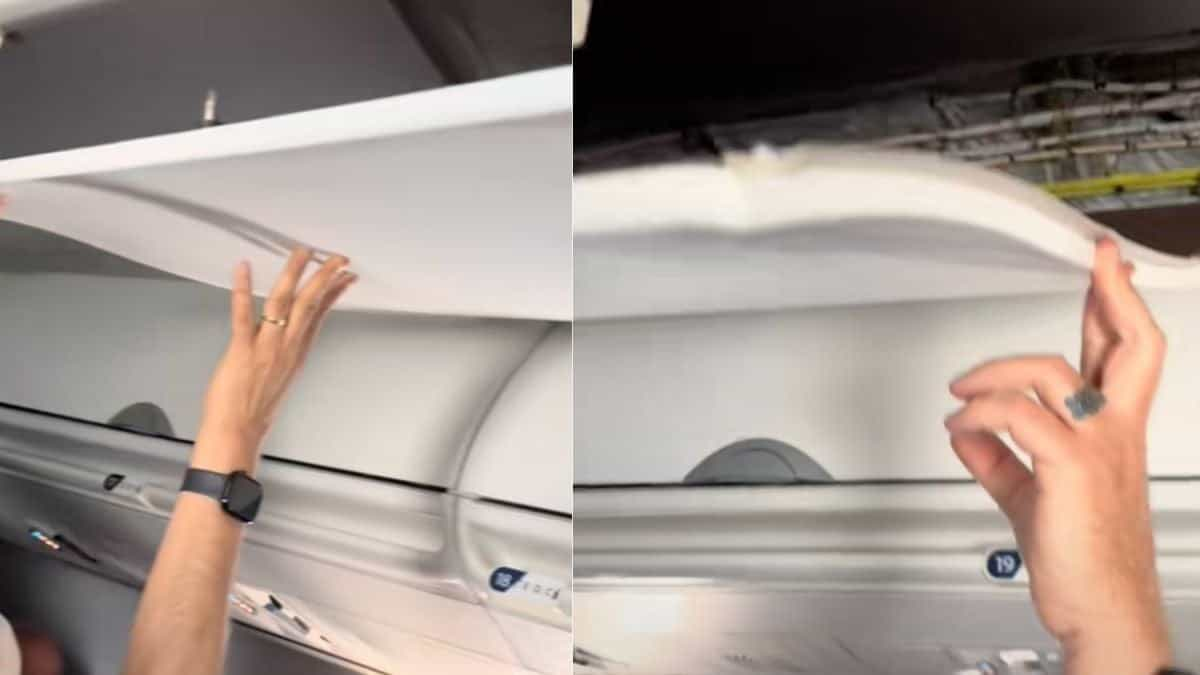Show table of content Hide table of content
A terrifying incident unfolded on April 14, 2025, when passengers aboard a Delta Air flight from Atlanta to Chicago faced an unprecedented emergency. The ceiling panel of the aircraft detached mid-flight, forcing passengers to use their hands to prevent it from completely collapsing. This alarming situation highlights growing concerns about aircraft maintenance and safety standards in commercial aviation.
Ceiling collapse creates mid-air emergency on Delta flight
What began as a routine domestic flight quickly turned into a nightmare scenario when the overhead panels began to detach while the aircraft was cruising at altitude. Passengers were suddenly thrust into an active role in maintaining the aircraft’s structural integrity, using their bare hands to hold up the collapsing ceiling panels.
According to eyewitness accounts shared on social media, travelers were forced to extend their arms upward to prevent the ceiling from completely giving way. The surreal scene was captured in videos that have since gone viral, showing passengers working together in a situation no safety briefing could have prepared them for.
News This TikToker buys a used van and realizes it has a hidden surveillance device.
“The ceiling just started coming down without warning,” reported one passenger. “Everyone around that section immediately reached up to hold it in place. We were terrified it might be connected to something critical.”
The flight crew eventually improvised a temporary solution by securing the loose panels with duct tape, a makeshift repair that allowed passengers to lower their tired arms. This emergency measure helped stabilize the situation until the aircraft could safely return to Atlanta. These types of unexpected in-flight incidents often reveal hidden aspects of aviation safety protocols that most travelers never anticipate encountering.
Passengers forced to return to Atlanta after the incident
Following the ceiling collapse, the flight crew made the decision to turn the aircraft around and return to Atlanta rather than continue to Chicago. This precautionary measure created significant disruption for travelers, who experienced delays of approximately two hours upon landing.
TikTok user Lucas Michael Payne shared details of the ordeal through a video posted on his account, stating that his friend was among those affected by the incident. “My friend was on the plane when the ceiling collapsed,” Payne explained in his viral post, which included startling footage of the damaged interior.
After returning to Atlanta, passengers were required to deplane and wait several hours before boarding another aircraft to complete their journey to Chicago. The unexpected travel disruption mirrors other surprising aviation decisions, such as when some individuals opt for alternative transportation lifestyles to avoid such uncertainties altogether.
The incident left many passengers shaken, with one traveler commenting, “I’ve always been nervous about flying, but I never imagined I’d be physically holding part of the plane together.” This type of experience can significantly impact passengers who already harbor fears of flying, potentially reinforcing aviation anxiety for years to come.
Delta’s response and compensation offer raises eyebrows
In the aftermath of the ceiling collapse, Delta Air’s handling of the situation has come under scrutiny. According to reports, the airline offered affected passengers compensation in the form of 10,000 miles, valued at approximately $100. Many travelers and aviation experts have questioned whether this gesture adequately addresses the severity of the incident.
“The compensation seems disproportionate to the experience,” noted one aviation analyst. “When passengers are literally holding parts of an aircraft together, it represents a significant safety concern that warrants more substantial recognition from the carrier.”
News Bat wings after 50? Here’s the most effective exercise, according to a coach.
Delta has yet to provide a detailed explanation regarding the cause of the ceiling collapse. The lack of transparency has prompted speculation about maintenance practices and the age of the aircraft involved. This incident joins a growing list of aviation close calls that have made headlines in recent years, similar to how miraculous escapes from dangerous situations often prompt investigations into safety measures.
The Federal Aviation Administration (FAA) has not yet commented on whether they will launch a formal investigation into the incident, though aviation experts predict such an inquiry is likely given the nature of the structural failure.
Growing pattern of incidents raises safety questions
This ceiling collapse represents just one in a series of concerning incidents involving Delta Air in recent months. In February 2025, another Delta aircraft reportedly overturned on the runway during landing at Toronto Pearson International Airport in Canada, though fortunately without serious injuries.
These successive incidents have prompted aviation safety advocates to call for more rigorous inspection protocols and maintenance standards. “When we see multiple incidents from the same carrier in a short timespan, it suggests possible systemic issues that require attention,” stated a former NTSB investigator.
The aviation industry has always faced unique challenges, from unpredictable weather phenomena like those studied by atmospheric scientists in extreme environments to mechanical failures. However, structural issues within the cabin present particularly alarming scenarios for passengers.
Industry experts compare this incident to other unexpected situations where humans must respond to sudden dangers, such as when individuals face wildlife threats that require immediate action or when marine scientists encounter unexpected behaviors from ocean predators.
As travelers increasingly share these experiences online, airlines face mounting pressure to address safety concerns transparently. Corporate leadership experts note that how companies respond to crises reveals much about their organizational culture, similar to how business leaders identify character traits during stressful situations.
For now, passengers booking future flights may find themselves casting nervous glances toward aircraft ceilings, wondering if they too might someday be called upon to become impromptu structural engineers at 30,000 feet.


